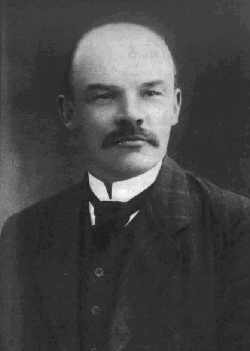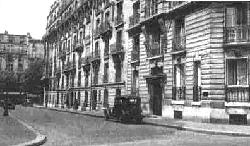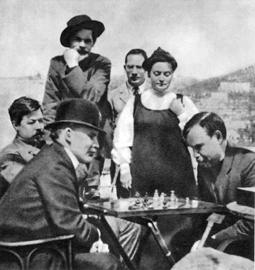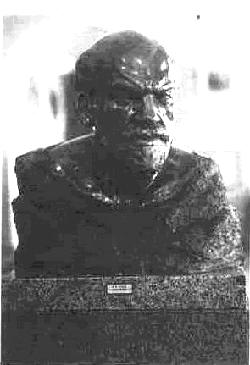Years of Reaction (1907-1910)
The tsarist government managed to suppress the revolution. It assumed the offensive on the working class and its Party. The distinguished figures of the Party and V.I.Lenin's comrades-in-arms, F. E. Dzerzhinsky, Y. M. Sverdlov, G. K. Orjonikidze, S. M. Kirov, M. I. Kalinin, M. V. Frunze and others behind prison bars and in exile are shown in the photographs. Upon the decision of the Bolshevik Party's leaders, Lenin left Russia illegally. The artist A. Rylov's painting portrays Lenin's crossing the Finnish Bay. It was wintertime. In spite of the intensely cold weather, the ice was thin in places, and in one place it started to break' beneath his feet. Lenin and his two companions, Finnish fishermen by chance escaped death. Thus began Lenin's second period of emigration which lasted almost ten years. (heard speeches: Contemporaries speak on Lenin at the Defend Lenin mausoleum! site) V. I. Lenin took up residence in Geneva, where he concentrated all his attention on the organisation of a Party press organ which became the newspaper Proletary (The Proletarian). Lenin had been in Geneva less than two months when the twenty-first issue of the illegal newspaper appeared. On display in this room are Lenin's articles "Revolution and Counter-Revolution", "The Third Duma", "On the Assessment of the Russian Revolution" and Others published in various issues of Proletary. In these articles he analyses the atmosphere in Russia after the defeat of the revolution and defines the prospects of further struggle. During this period Lenin devoted much of hi” attention to the solution of the agrarian problem, which was of great significance for the Russian revolution.
The photographs located in this room recount the Fifth All-Russia Conference of the RSDLP taking place in Paris in 1908. In the documents from the conference the importance of a skilful combination of illegal and legal work was emphasised, and the opportunist tactics of the Menshevik liquidators, who shamefully renounced the Party Programme, seeking liquidation (thus they were called liquidators) of the Party's illegal organisation and the cessation of underground revolutionary work, were condemned. The building where the conference was held is shown in one of the photographs. The first edition of V. I. Lenin's work, Materialism and Empiric-Criticism, which appeared in May 1909 under the pseudonym "V. L. llyin", is on display in the centre of this hall. On the exhibition stand and revolving stand are presented photostat copies of individual pages of the book, part of the literature in English, French and German, which Lenin used while writing this book. Here also is a model of the reading room in library of the British Museum where Lenin worked on the book. A thorough critical analysis of the bourgeois idealist philosophy and philosophical revisionism exposing its latest methods of defending idealism is given in this work, and also the basic questions of Marxist philosophy are substantiated and developed. Even today this work remains a sharp weapon for the Party in the struggle against modern bourgeois idealistic philosophy.
Lenin during his visit to Capri where he was a guest of Maxim Gorky. 1908.V. I. Lenin visited the island of Capri in the spring of 1908 upon the invitation of the writer A. M. Gorky. One of the photographs shows Lenin playing chess on the terrace in Gorky's home. (see Maxim Gorky's article about Lenin at the Defend Lenin mausoleum! site)
A New Rise of the Revolutionary Tide (1910-1914) |





